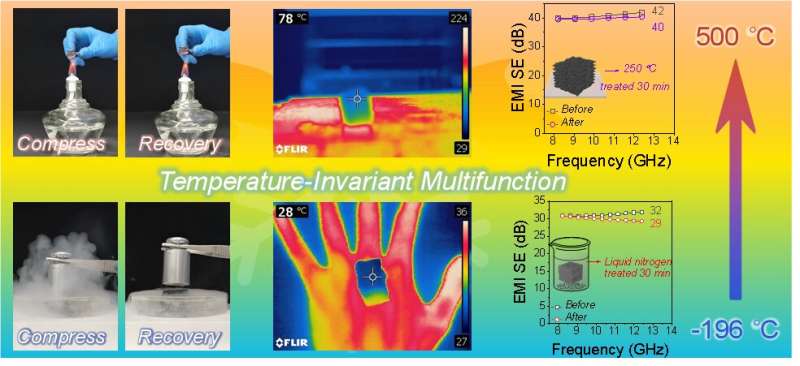
Aerogel materials serve a vital role as protective materials needed for many fields, including as electromagnetic interference shielding material for 5G technology, thermally insulating material in high-rise buildings and infrared stealth material for military applications. Current protective materials, however, often lose their protective functions under harsh conditions such as extreme temperatures, rendering them ineffective. Other protective materials lose their elasticity, leading to similar performance issues. Now, new aerogel materials that can maintain their functionality and superelasticity under extreme temperatures have been developed by a team of researchers from Sichuan University.
The results were published in Nano Research.
“We aimed to solve the problem that the performance of conventional protective aerogel materials deteriorates severely under harsh working conditions,” said corresponding author Hai-Bo Zhao, professor in the College of Chemistry at Sichuan University.
Prior to Zhao’s team’s developments, polymer-based foam materials were commonly used as protective materials. These materials exhibited the positive traits of superelasticity and high compressibility but were unable to maintain these properties after the melting temperatures of the polymers. Another commonly used material were metallic and ceramic foams, which were stable across temperature ranges in a way that their polymer-based foam counterparts were not but did not have the elasticity needed to be practical.
An approach that came closer to a scalable solution involved using carbon aerogels, which have characteristics that lend themselves well to thermal insulation and electromagnetic interference, such as high specific surface area, low density, good electrical conductivity and chemical and thermal stability. However, carbon aerogels have limitations due to certain inherent properties. Carbon nanotubes became a popular way to construct superelastic carbon aerogels, since they could maintain the needed properties at high temperatures, but because the preparation required so many steps, the methods were not scalable.
By focusing on the microstructure design, Zhao’s team was able to develop a polymer aerogel with superelasticity that functioned in a temperature range of -196 to 500°C with a process that was scalable and practical.
“Unlike most carbon aerogels reported previously that usually possess poor mechanical properties, the prepared aerogel materials exhibit temperature-invariant superelasticity while maintaining multifunctional protective performance,” said Zhao, who is also affiliated with the National Engineering Laboratory for Eco-Friendly Polymeric Materials in Sichuan and with the Collaborative Innovation Center for Eco-Friendly and Fire-Safety Polymeric Materials.
Zhao’s method uses bidirectionally oriented carbon/carbon aerogel composite multi-walled carbon nanotubes—in other words, a combination that allows for combining the positive traits of carbon aerogels with the positive traits of carbon nanotubes—with a highly ordered carbon skeleton, one of the key differentiators between this new method and previous methods. Their scalable method of achieving the desired microstructures—specifically, highly oriented arch structures—involves a bidirectional freezing and carbonization process to develop the carbon/carbon aerogels.
“The reported aerogel materials maintain superelasticity, high electromagnetic interference shielding effectiveness, thermal insulation and infrared stealth in a wide temperature range from -196 to 500 °C and after cyclic compression for hundreds of times,” Zhao said. “The most exciting aspect is the economic and simple preparation process, which laid the foundation of the potential practical application of the material.”
Zhao said that the next step is to make the aerogels available for use in commercial, military and other contexts.
“We would like to promote the industrialization of the reported aerogel and further the application in 5G technology, high rise buildings, military use and more,” he said.
More information:
Bo-Wen Liu et al, Multifunctional protective aerogel with superelasticity over −196 to 500 °C, Nano Research (2022). DOI: 10.1007/s12274-022-4699-2
Journal information:Nano Research
Provided by
Tsinghua University Press

READ MORE
5 Ways to Soothe Skin After a Glycolic Peel
In the end, a chemical peel can work wonders, but it can be a painful [...]
What an Asteroid Could Tell Us About Ancient Earth
Bennu is shaped like a three-dimensional diamond and seemingly smooth from far away. OSIRIS-REx is [...]
Graphite nanoplatelets on medical devices kill bacteria and prevent infections
Graphite nanoplatelets integrated into plastic medical surfaces can prevent infections, killing 99.99 per cent of [...]
New strategy for high-performance cathodes in aqueous zinc ion batteries
The electrochemically induced phase transformation behaviors of the V6O13 cathode. Credit: Mo Li’e A new [...]
Six Ways to Celebrate Perseverance This February
Perseverance Rover on Mars ( NASA Illustration) On Thursday, February 18, 2021, Perseverance, a NASA [...]
Coral Bleaching on the Great Barrier Reef May Get a Lot Worse in the Future
Coral bleaching Peter Mumby A massive coral bleaching event has struck the Great Barrier Reef, [...]
How to Clean the Idle Air Sensor Control Motor
An idle air control valve, also known as an idle air sensor control motor, is [...]
Quick Tips: What is AntiGravity Yoga?
Antigravity yoga can provide a new challenge to your yoga routine. RyanJLane/Getty Images For the [...]